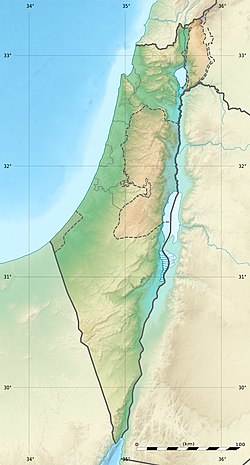
Back Adul·lam Catalan Adulam Welsh Liste geographischer und ethnographischer Bezeichnungen in der Bibel#A German Αδουλλάμ Greek Ádullam Spanish Adullam French עדולם HE Adullam Polish Adulão Portuguese Адоллам Russian
Khirbat esh-Sheikh Madkur / ʿAīd el Mâ | |
 Pine-covered hill of Adullam, seen from northwest | |
| Alternative name | 'Eîd el Mieh (Kh. 'Id el-Minya) |
|---|---|
| Location | Israel |
| Region | Shfela |
| Coordinates | 31°39′0″N 35°0′9″E / 31.65000°N 35.00250°E |
| Grid position | 150/118 PAL |
| History | |
| Founded | Canaanite period and successive periods |
| Abandoned | unknown |
| Periods | Chalcolithic, Early and Late Bronze, Iron Age periods to the Ottoman period |
| Cultures | Canaanite, Jewish, Greco-Roman, Byzantine, early Islamic, Ottoman |
| Site notes | |
| Excavation dates | 2015 |
| Archaeologists | Surveyed by Y. Dagan, B. Zissu, I. Radashkovsky and E. Liraz |
| Condition | Ruin |
| Ownership | Jewish National Fund |
| Public access | yes |

Adullam (Hebrew: עֲדֻלָּם, romanized: ʿəḏullām, Koinē Greek: Οδολλάμ) is an ancient ruin once numbered among the thirty-six cities of Canaan whose kings "Joshua and the children of Israel smote" (Joshua 12:7–24).[1] After that, it fell as an inheritance to the tribe of Judah and was included in the northern division of the Shephelah "lowland" cities of the land of Judah (Joshua 15:35).[2] Adullam is mentioned multiple times in the Hebrew Bible, including events featuring David who took refuge at Adullam, escaping King Saul. At this time Adullam was close to the land of the Philistines.
The current site is also known by the Arabic name Khurbet esh-Sheikh Madhkur, 9 mi. (15 km.) northeast of Bayt Jibrin,[3] and was built upon a hilltop overlooking the Elah valley, straddling the Green Line between Israel and the West Bank, and with its suburban ruin, Levantine Arabic: عيد الميا, romanized: ʿeyd el-Miye, lying directly below it.[4] By the late 19th century, the settlement, which had been a town, was in ruins.[5] The hilltop ruin is named after Madkour, one of the sons of the Sultan Beder, for whom is built a shrine (wely) and formerly called by its inhabitants Wely Madkour.[6]
The hilltop is mostly flat, with cisterns carved into the rock. The remains of stone structures which once stood there can still be seen. Sedimentary layers of ruins from the old Canaanite and Israelite eras, mostly potsherds, are noticeable everywhere, although olive groves now grow atop of this hill, enclosed within stonewall enclosures. The villages of Aderet, Aviezer and Khirbet al-Deir are located nearby. The ruin lies about 3 km (1.9 mi) south of moshav Neve Michael. The site has been surveyed archaeologically and was partially excavated in 2015.
- ^ Clermont-Ganneau 1875, p. 170
- ^ Cite error: The named reference
AmitDavidwas invoked but never defined (see the help page). - ^ Avi-Yonah 1973, p. 311.
- ^ Survey of Israel, Map 15-11 "Zurif", 1962.[:File:15-11-Zurif-1962.jpg]
- ^ Conder & Kitchener 1883, p. 311; On Palestine Exploration Fund Map: Hebron (Sheet XXI), the ruin of Khurbet 'Aid el Ma [sic] appears directly to the north of Khurbet esh-Sheikh Madhkur, in the valley below. The ancient ruin is distinguished by its many razed structures lying in a field the size of a football field, interspersed with terebinths, directly alongside a small paved road that runs parallel to the main Roglit – Aderet road: see Survey of Western Palestine, 1878 Map, Map 21: IAA, Wikimedia commons, as surveyed and drawn under the direction of Lieut. C.R. Conder and H.H. Kitchener, May 1878. Victor Guerin believed that there was once an Upper Adullam and a Lower Adullam.
- ^ Conder & Kitchener 1883, pp. 361–367.
